2024届高考英语二轮复习阅读理解说明文解题技巧课件(共35张PPT)
文档属性
| 名称 | 2024届高考英语二轮复习阅读理解说明文解题技巧课件(共35张PPT) |  | |
| 格式 | pptx | ||
| 文件大小 | 4.4MB | ||
| 资源类型 | 教案 | ||
| 版本资源 | 通用版 | ||
| 科目 | 英语 | ||
| 更新时间 | 2024-04-19 11:21:18 | ||
图片预览

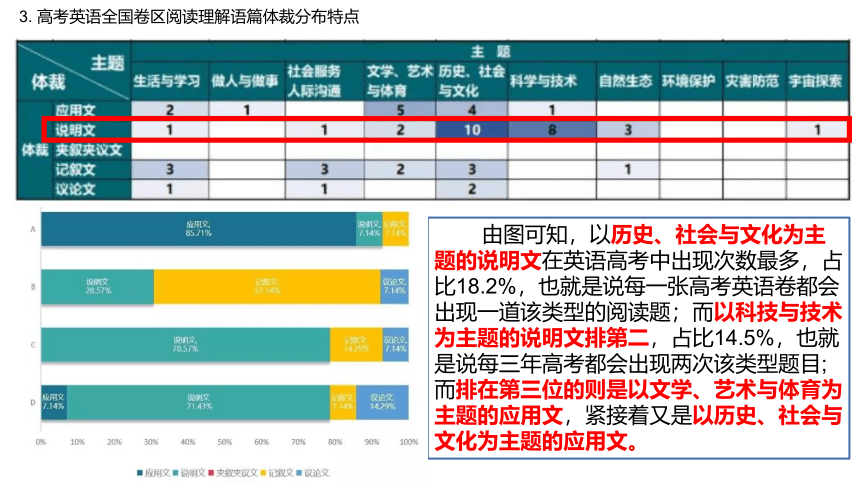
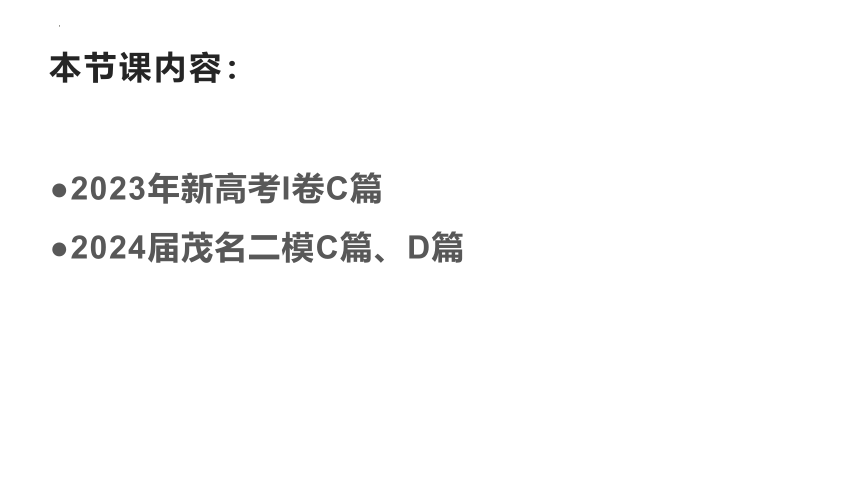
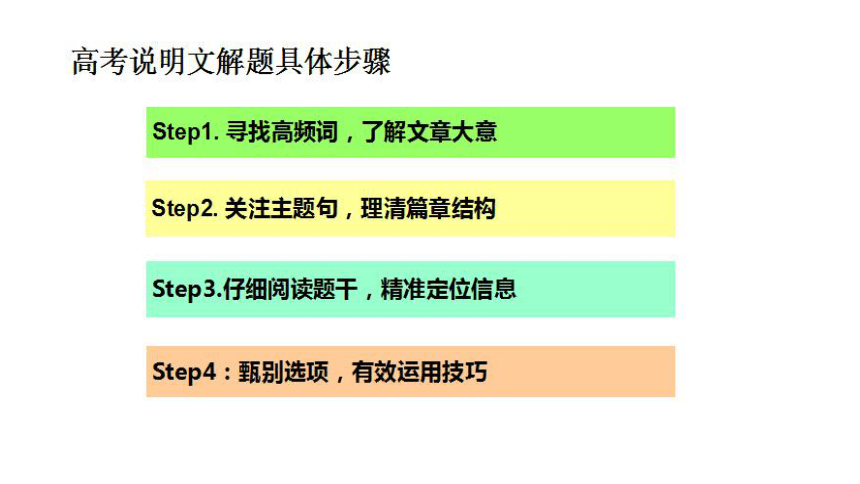



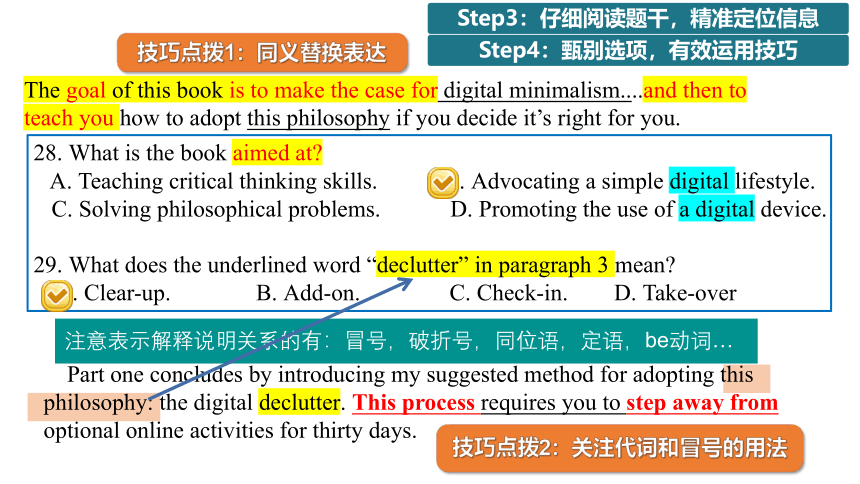

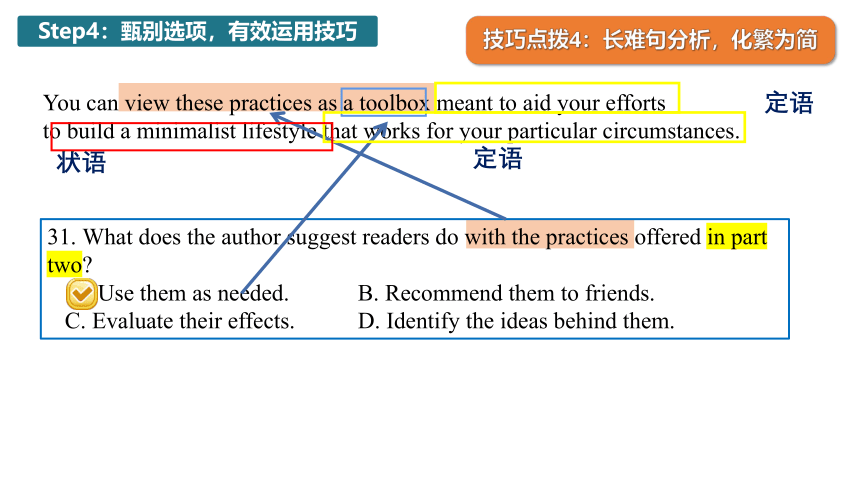


文档简介
(共35张PPT)
高考科普说明文
中的解题技巧
3. 高考英语全国卷区阅读理解语篇体裁分布特点
由图可知,以历史、社会与文化为主题的说明文在英语高考中出现次数最多,占比18.2%,也就是说每一张高考英语卷都会出现一道该类型的阅读题;而以科技与技术为主题的说明文排第二,占比14.5%,也就是说每三年高考都会出现两次该类型题目;而排在第三位的则是以文学、艺术与体育为主题的应用文,紧接着又是以历史、社会与文化为主题的应用文。
本节课内容:
2023年新高考I卷C篇
2024届茂名二模C篇、D篇
历史、社会、文化
min/mini- : less, small, 小,少
minor少数的, minimize最小化, minibus, miniskirt,minimal最小的
-sm :某种群体意识形态/主义capitalism资本主义,socialism社会主义,tourism旅游业
de-: 减少 decrease, decline, descend, depress
The goal of this book is to make the case for digital minimalism, including a detailed exploration of what it asks and why it works, and then to teach you how to adopt if you decide it’s right for you.
To do so, I divided the book into two parts. In part one, I describe the philosophical foundations of digital minimalism, starting with an examination of the forces that are making so many people’s digital lives increasingly intolerable, before moving on to a detailed discussion of the digital minimalism philosophy.
Part one concludes by introducing my suggested method for adopting this philosophy: the digital declutter. This process requires you to step away from optional online activities for thirty days. At the end of the thirty days, you will then add back a small number of carefully chosen online activities that you believe will provide massive benefits to the things you value.
In the final chapter of part one, I’ll guide you through carrying out your own digital declutter. In doing so, I’ll draw on an experiment I ran in 2018 in which over 1,600 people agreed to perform a digital declutter. You’ll hear these participants’ stories and learn what strategies worked well for them, and what traps they encountered that you should avoid.
The second part of this book takes a closer look at some ideas that will help you cultivate (培养) a sustainable digital minimalism lifestyle. In these chapters, I examine issues such as the importance of solitude (独处) and the necessity of cultivating high-quality leisure to replace the time most now spend on mindless device use. Each chapter concludes with a collection of practices, which are designed to help you act on the big ideas of the chapter. You can view these practices as a toolbox meant to aid your efforts to build a minimalist lifestyle that works for your particular circumstances.
(2023 年新高考I卷C篇 )
Step1:寻找高频词,了解文章大意
Main idea: Introduce a book about digital minimalism philosophy.
The goal of this book is to make the case for digital minimalism, including a detailed exploration of what it asks and why it works, and then to teach you how to adopt this philosophy if you decide it’s right for you.
To do so, I divided the book into two parts. In part one, I describe the philosophical foundations of digital minimalism, starting with an examination of the forces that are making so many people’s digital lives increasingly intolerable, before moving on to a detailed discussion of the digital minimalism philosophy.
Part one concludes by introducing my suggested method for adopting this philosophy: the digital declutter. This process requires you to step away from optional online activities for thirty days. At the end of the thirty days, you will then add back a small number of carefully chosen online activities that you believe will provide massive benefits to the things you value.
In the final chapter of part one, I’ll guide you through carrying out your own digital declutter. In doing so, I’ll draw on an experiment I ran in 2018 in which over 1,600 people agreed to perform a digital declutter. You’ll hear these participants’ stories and learn what strategies worked well for them, and what traps they encountered that you should avoid.
The second part of this book takes a closer look at some ideas that will help you cultivate (培养) a sustainable digital minimalism lifestyle. In these chapters, I examine issues such as the importance of solitude (独处) and the necessity of cultivating high-quality leisure to replace the time most now spend on mindless device use. Each chapter concludes with a collection of practices, which are designed to help you act on the big ideas of the chapter. You can view these practices as a toolbox meant to aid your efforts to build a minimalist lifestyle that words for your particular circumstances.
(2023 年新高考I卷 )
Step2:关注主题句,理清文章结构
2023
C卷
para.1:
para.2-4:
para.5
介绍书的写作目的
介绍书的第一章节:
介绍书的第二章节:
语篇结构
总分总
总分
28. What is the book aimed at
A. Teaching critical thinking skills. B. Advocating a simple digital lifestyle.
C. Solving philosophical problems. D. Promoting the use of a digital device.
29. What does the underlined word “declutter” in paragraph 3 mean
A. Clear-up. B. Add-on. C. Check-in. D. Take-over
The goal of this book is to make the case for digital minimalism....and then to teach you how to adopt this philosophy if you decide it’s right for you.
技巧点拨1:同义替换表达
Step4:甄别选项,有效运用技巧
Part one concludes by introducing my suggested method for adopting this philosophy: the digital declutter. This process requires you to step away from optional online activities for thirty days.
技巧点拨2:关注代词和冒号的用法
注意表示解释说明关系的有:冒号,破折号,同位语,定语,be动词…
Step3:仔细阅读题干,精准定位信息
Step4:甄别选项,有效运用技巧
30. What is presented in the final chapter of part one
A. Theoretical models. B. Statistical methods.
C. Practical examples. D. Historical analyses.
In the final chapter of part one, I’ll guide you through carrying out your own digital declutter. In doing so, I’ll draw on an experiment I ran in 2018 in which over 1,600 people agreed to perform a digital declutter. You’ll hear these participants’ stories and learn what strategies worked well for them, and what traps they encountered that you should avoid.
技巧点拨3:分析词汇的上下义词
C选项中的examples是作者所利用实验具体的内容:参加者的故事,所学的策略,他们遇到的困境。
Step4:甄别选项,有效运用技巧
31. What does the author suggest readers do with the practices offered in part two
A. Use them as needed. B. Recommend them to friends.
C. Evaluate their effects. D. Identify the ideas behind them.
You can view these practices as a toolbox meant to aid your efforts
to build a minimalist lifestyle that works for your particular circumstances.
技巧点拨4:长难句分析,化繁为简
定语
状语
定语
Review
1)介绍描述类:(被介绍对象+特征1+特征2+特征3+总结)
2) 构词法:mini-/de-/-sm
3)长难句:三长(非谓语、从句、介词短语)两短(形容词、副词)
转至茂名二模
(2023 年新高考I卷D篇 )
On March 7, 1907, the English statistician Francis Galton published a paper which illustrated what has come to be known as the “wisdom of crowds” effect. The experiment of estimation he conducted showed that in some cases, the average of a large number of independent estimates could be quite accurate.
This effect capitalizes on the fact that when people make errors, those errors aren’t always the same. Some people will tend to overestimate, and some to underestimate. When enough of these errors are averaged together, they cancel each other out, resulting in a more accurate estimate. If people are similar and tend to make the same errors, then their errors won’t cancel each other out. In more technical terms, the wisdom of crowds requires that people’s estimates be independent. If for whatever reasons, people’s errors become correlated or dependent, the accuracy of the estimate will go down.
But a new study led by Joaquin Navajas offered an interesting twist (转折) on this classic phenomenon. The key finding of the study was that when crowds were further divided into smaller groups that were allowed to have a discussion, the averages from these groups were more accurate than those from an equal number of independent individuals. For instance, the average obtained from the estimates of four discussion groups of five was significantly more accurate than the average obtained from 20 independent individuals.
In a follow-up study with 100 university students, the researchers tried to get a better sense of what the group members actually did in their discussion. Did they tend to go with those most confident about their estimates Did they follow those least willing to change their minds This happened some of the time, but it wasn’t the dominant response. Most frequently, the groups reported that they “shared arguments and reasoned together.” Somehow, these arguments and reasoning resulted in a global reduction in error. Although the studies led by Navajas have limitations and many questions remain the potential implications for group discussion and decision-making are enormous.
2023
全国
1卷D
para.1-2:
para.3:
para.4:
介绍过去的研究
介绍新的研究
介绍后续的研究
语篇结构
总分总
总分
What does the author inform us of _______
A. an object
B. a social phenomenon
C. a research report...
32. What is paragraph 2 of the text mainly about
A. The methods of estimation. B. The underlying logic of the effect.
C. The causes of people’s errors. D. The design of Galton’s experiment.
This effect capitalizes on the fact that when people make errors, those errors aren’t always the same. Some people will tend to overestimate, and some to underestimate. When enough of these errors are averaged together, they cancel each other out, resulting in a more accurate estimate. If people are similar and tend to make the same errors, then their errors won’t cancel each other out. In more technical terms, the wisdom of crowds requires that people’s estimates be independent. If for whatever reasons, people’s errors become correlated or dependent, the accuracy of the estimate will go down.
注意:文中when, if 可理解为条件状从。引导条件状从的词还有:
Unless,as/so long as, once, in case, on condition that, supposing that, providing/provided that, given that
技巧点拨5:关注信号词,分析句际关系
33. Navajas’ study found that the average accuracy could increase even if ______.
A. the crowds were relatively small B. there were occasional underestimates
C. individuals did not communicate D. estimates were not fully independent
This effect capitalizes on the fact that when people make errors, those errors aren’t always the same. Some people will tend to overestimate, and some to underestimate. When enough of these errors are averaged together, they cancel each other out, resulting in a more accurate estimate. If people are similar and tend to make the same errors, then their errors won’t cancel each other out. In more technical terms, the wisdom of crowds requires that people’s estimates be independent. If for whatever reasons, people’s errors become correlated or dependent, the accuracy of the estimate will go down.
But a new study led by Joaquin Navajas offered an interesting twist (转折) on this classic phenomenon. The key finding of the study was that when crowds were further divided into smaller groups that were allowed to have a discussion, the averages from these groups were more accurate than those from an equal number of independent individuals.
②
③
注意:表转折关系的词有:but, however, nevertheless, yet, though….
技巧点拨5:关注信号词,分析段际关系
34. What did the follow-up study focus on
A. The size of the groups. B. The dominant members.
C. The discussion process. D. The individual estimates.
35. What is the author’s attitude toward Navajas’ studies
A. Unclear. B. Dismissive. C. Doubtful. D. Approving.
In a follow-up study with 100 university students, the researchers tried to get a better sense of what the group members actually did in their discussion. Did they tend to go with those most confident about their estimates Did they follow those least willing to change their minds This happened some of the time, but it wasn’t the dominant response. Most frequently, the groups reported that they “shared arguments and reasoned together.” Somehow, these arguments and reasoning resulted in a global reduction in error. Although the studies led by Navajas have limitations and many questions remain, the potential implications for group discussion and decision-making are enormous.
技巧点拨1:同义替换表达
技巧点拨6:积累观点态度词,明确作者观点态度
技巧点拨7:关注中心词及首段,结尾段
赞成
positive 积极的
supportive 支持的
approving 赞成的
favorable 赞许的
反对
negative 消极的
disapproving 不赞成的
dissatisfied 不满意的
critical 批判的
worried 担忧的
doubtful 怀疑的
中立
objective客观的
neutral中立的
indifferent 漠不关心的
作者的态度:What’s the author’s attitude(态度)towards...
不清楚的
unclear 消极的
vague 模糊分
ambiguous
模棱两可的
2)研究报告类:
研究报告的主题(第一二段:问题/现象/旧研究-新研究)+(过程、方法、发现、应用)+专家评议
实践运用
--茂名二模C、D篇
P1:研究结果
主题(首段):太极对于在高血压前期降低血压的效果比更有氧运动好。
P2- P5:过程、方法、发现、应用
P6:专家评议
Step1:寻找高频词,了解文章大意
Step2:关注主题句,理清文章结构
Step3:仔细阅读题干,精准定位信息
研究主题:第一段
研究过程:2-3段
研究过程:太极的特点,优点
专家评议:最后一段
赞成
positive 积极的
supportive 支持的
approving 赞成的
favorable 赞许的
反对
negative 消极的
disapproving 不赞成的
dissatisfied 不满意的
critical 批判的
worried 担忧的
doubtful 怀疑的
中立
objective客观的
neutral中立的
indifferent 漠不关心的
作者的态度:What’s the author’s attitude(态度)towards...
不清楚的
unclear 消极的
vague 模糊分
ambiguous
模棱两可的
Review:
2)研究报告类:
研究报告的主题(第一二段:问题/现象/旧研究-新研究)+研究过程/研究方法/研究发现/实践应用+专家评议
P1:介绍主题:Cloud; 目的
P2-6:重要性、过程、原理、用途、前景
3)新鲜科技类
(新鲜科技的独特性+过程+原理+用途+前景)
Summary
语篇结构:
1)介绍描述类
被介绍对象+特征1+特征2+特征3+总结
2)研究报告类:
研究报告的主题(第一二段:问题/现象/旧研究-新研究)+(过程、方法、发现、应用)+专家评议
3)新鲜科技类
新鲜科技的独特性+过程+原理+用途+前景
Self-evaluation
高考科普说明文
中的解题技巧
3. 高考英语全国卷区阅读理解语篇体裁分布特点
由图可知,以历史、社会与文化为主题的说明文在英语高考中出现次数最多,占比18.2%,也就是说每一张高考英语卷都会出现一道该类型的阅读题;而以科技与技术为主题的说明文排第二,占比14.5%,也就是说每三年高考都会出现两次该类型题目;而排在第三位的则是以文学、艺术与体育为主题的应用文,紧接着又是以历史、社会与文化为主题的应用文。
本节课内容:
2023年新高考I卷C篇
2024届茂名二模C篇、D篇
历史、社会、文化
min/mini- : less, small, 小,少
minor少数的, minimize最小化, minibus, miniskirt,minimal最小的
-sm :某种群体意识形态/主义capitalism资本主义,socialism社会主义,tourism旅游业
de-: 减少 decrease, decline, descend, depress
The goal of this book is to make the case for digital minimalism, including a detailed exploration of what it asks and why it works, and then to teach you how to adopt if you decide it’s right for you.
To do so, I divided the book into two parts. In part one, I describe the philosophical foundations of digital minimalism, starting with an examination of the forces that are making so many people’s digital lives increasingly intolerable, before moving on to a detailed discussion of the digital minimalism philosophy.
Part one concludes by introducing my suggested method for adopting this philosophy: the digital declutter. This process requires you to step away from optional online activities for thirty days. At the end of the thirty days, you will then add back a small number of carefully chosen online activities that you believe will provide massive benefits to the things you value.
In the final chapter of part one, I’ll guide you through carrying out your own digital declutter. In doing so, I’ll draw on an experiment I ran in 2018 in which over 1,600 people agreed to perform a digital declutter. You’ll hear these participants’ stories and learn what strategies worked well for them, and what traps they encountered that you should avoid.
The second part of this book takes a closer look at some ideas that will help you cultivate (培养) a sustainable digital minimalism lifestyle. In these chapters, I examine issues such as the importance of solitude (独处) and the necessity of cultivating high-quality leisure to replace the time most now spend on mindless device use. Each chapter concludes with a collection of practices, which are designed to help you act on the big ideas of the chapter. You can view these practices as a toolbox meant to aid your efforts to build a minimalist lifestyle that works for your particular circumstances.
(2023 年新高考I卷C篇 )
Step1:寻找高频词,了解文章大意
Main idea: Introduce a book about digital minimalism philosophy.
The goal of this book is to make the case for digital minimalism, including a detailed exploration of what it asks and why it works, and then to teach you how to adopt this philosophy if you decide it’s right for you.
To do so, I divided the book into two parts. In part one, I describe the philosophical foundations of digital minimalism, starting with an examination of the forces that are making so many people’s digital lives increasingly intolerable, before moving on to a detailed discussion of the digital minimalism philosophy.
Part one concludes by introducing my suggested method for adopting this philosophy: the digital declutter. This process requires you to step away from optional online activities for thirty days. At the end of the thirty days, you will then add back a small number of carefully chosen online activities that you believe will provide massive benefits to the things you value.
In the final chapter of part one, I’ll guide you through carrying out your own digital declutter. In doing so, I’ll draw on an experiment I ran in 2018 in which over 1,600 people agreed to perform a digital declutter. You’ll hear these participants’ stories and learn what strategies worked well for them, and what traps they encountered that you should avoid.
The second part of this book takes a closer look at some ideas that will help you cultivate (培养) a sustainable digital minimalism lifestyle. In these chapters, I examine issues such as the importance of solitude (独处) and the necessity of cultivating high-quality leisure to replace the time most now spend on mindless device use. Each chapter concludes with a collection of practices, which are designed to help you act on the big ideas of the chapter. You can view these practices as a toolbox meant to aid your efforts to build a minimalist lifestyle that words for your particular circumstances.
(2023 年新高考I卷 )
Step2:关注主题句,理清文章结构
2023
C卷
para.1:
para.2-4:
para.5
介绍书的写作目的
介绍书的第一章节:
介绍书的第二章节:
语篇结构
总分总
总分
28. What is the book aimed at
A. Teaching critical thinking skills. B. Advocating a simple digital lifestyle.
C. Solving philosophical problems. D. Promoting the use of a digital device.
29. What does the underlined word “declutter” in paragraph 3 mean
A. Clear-up. B. Add-on. C. Check-in. D. Take-over
The goal of this book is to make the case for digital minimalism....and then to teach you how to adopt this philosophy if you decide it’s right for you.
技巧点拨1:同义替换表达
Step4:甄别选项,有效运用技巧
Part one concludes by introducing my suggested method for adopting this philosophy: the digital declutter. This process requires you to step away from optional online activities for thirty days.
技巧点拨2:关注代词和冒号的用法
注意表示解释说明关系的有:冒号,破折号,同位语,定语,be动词…
Step3:仔细阅读题干,精准定位信息
Step4:甄别选项,有效运用技巧
30. What is presented in the final chapter of part one
A. Theoretical models. B. Statistical methods.
C. Practical examples. D. Historical analyses.
In the final chapter of part one, I’ll guide you through carrying out your own digital declutter. In doing so, I’ll draw on an experiment I ran in 2018 in which over 1,600 people agreed to perform a digital declutter. You’ll hear these participants’ stories and learn what strategies worked well for them, and what traps they encountered that you should avoid.
技巧点拨3:分析词汇的上下义词
C选项中的examples是作者所利用实验具体的内容:参加者的故事,所学的策略,他们遇到的困境。
Step4:甄别选项,有效运用技巧
31. What does the author suggest readers do with the practices offered in part two
A. Use them as needed. B. Recommend them to friends.
C. Evaluate their effects. D. Identify the ideas behind them.
You can view these practices as a toolbox meant to aid your efforts
to build a minimalist lifestyle that works for your particular circumstances.
技巧点拨4:长难句分析,化繁为简
定语
状语
定语
Review
1)介绍描述类:(被介绍对象+特征1+特征2+特征3+总结)
2) 构词法:mini-/de-/-sm
3)长难句:三长(非谓语、从句、介词短语)两短(形容词、副词)
转至茂名二模
(2023 年新高考I卷D篇 )
On March 7, 1907, the English statistician Francis Galton published a paper which illustrated what has come to be known as the “wisdom of crowds” effect. The experiment of estimation he conducted showed that in some cases, the average of a large number of independent estimates could be quite accurate.
This effect capitalizes on the fact that when people make errors, those errors aren’t always the same. Some people will tend to overestimate, and some to underestimate. When enough of these errors are averaged together, they cancel each other out, resulting in a more accurate estimate. If people are similar and tend to make the same errors, then their errors won’t cancel each other out. In more technical terms, the wisdom of crowds requires that people’s estimates be independent. If for whatever reasons, people’s errors become correlated or dependent, the accuracy of the estimate will go down.
But a new study led by Joaquin Navajas offered an interesting twist (转折) on this classic phenomenon. The key finding of the study was that when crowds were further divided into smaller groups that were allowed to have a discussion, the averages from these groups were more accurate than those from an equal number of independent individuals. For instance, the average obtained from the estimates of four discussion groups of five was significantly more accurate than the average obtained from 20 independent individuals.
In a follow-up study with 100 university students, the researchers tried to get a better sense of what the group members actually did in their discussion. Did they tend to go with those most confident about their estimates Did they follow those least willing to change their minds This happened some of the time, but it wasn’t the dominant response. Most frequently, the groups reported that they “shared arguments and reasoned together.” Somehow, these arguments and reasoning resulted in a global reduction in error. Although the studies led by Navajas have limitations and many questions remain the potential implications for group discussion and decision-making are enormous.
2023
全国
1卷D
para.1-2:
para.3:
para.4:
介绍过去的研究
介绍新的研究
介绍后续的研究
语篇结构
总分总
总分
What does the author inform us of _______
A. an object
B. a social phenomenon
C. a research report...
32. What is paragraph 2 of the text mainly about
A. The methods of estimation. B. The underlying logic of the effect.
C. The causes of people’s errors. D. The design of Galton’s experiment.
This effect capitalizes on the fact that when people make errors, those errors aren’t always the same. Some people will tend to overestimate, and some to underestimate. When enough of these errors are averaged together, they cancel each other out, resulting in a more accurate estimate. If people are similar and tend to make the same errors, then their errors won’t cancel each other out. In more technical terms, the wisdom of crowds requires that people’s estimates be independent. If for whatever reasons, people’s errors become correlated or dependent, the accuracy of the estimate will go down.
注意:文中when, if 可理解为条件状从。引导条件状从的词还有:
Unless,as/so long as, once, in case, on condition that, supposing that, providing/provided that, given that
技巧点拨5:关注信号词,分析句际关系
33. Navajas’ study found that the average accuracy could increase even if ______.
A. the crowds were relatively small B. there were occasional underestimates
C. individuals did not communicate D. estimates were not fully independent
This effect capitalizes on the fact that when people make errors, those errors aren’t always the same. Some people will tend to overestimate, and some to underestimate. When enough of these errors are averaged together, they cancel each other out, resulting in a more accurate estimate. If people are similar and tend to make the same errors, then their errors won’t cancel each other out. In more technical terms, the wisdom of crowds requires that people’s estimates be independent. If for whatever reasons, people’s errors become correlated or dependent, the accuracy of the estimate will go down.
But a new study led by Joaquin Navajas offered an interesting twist (转折) on this classic phenomenon. The key finding of the study was that when crowds were further divided into smaller groups that were allowed to have a discussion, the averages from these groups were more accurate than those from an equal number of independent individuals.
②
③
注意:表转折关系的词有:but, however, nevertheless, yet, though….
技巧点拨5:关注信号词,分析段际关系
34. What did the follow-up study focus on
A. The size of the groups. B. The dominant members.
C. The discussion process. D. The individual estimates.
35. What is the author’s attitude toward Navajas’ studies
A. Unclear. B. Dismissive. C. Doubtful. D. Approving.
In a follow-up study with 100 university students, the researchers tried to get a better sense of what the group members actually did in their discussion. Did they tend to go with those most confident about their estimates Did they follow those least willing to change their minds This happened some of the time, but it wasn’t the dominant response. Most frequently, the groups reported that they “shared arguments and reasoned together.” Somehow, these arguments and reasoning resulted in a global reduction in error. Although the studies led by Navajas have limitations and many questions remain, the potential implications for group discussion and decision-making are enormous.
技巧点拨1:同义替换表达
技巧点拨6:积累观点态度词,明确作者观点态度
技巧点拨7:关注中心词及首段,结尾段
赞成
positive 积极的
supportive 支持的
approving 赞成的
favorable 赞许的
反对
negative 消极的
disapproving 不赞成的
dissatisfied 不满意的
critical 批判的
worried 担忧的
doubtful 怀疑的
中立
objective客观的
neutral中立的
indifferent 漠不关心的
作者的态度:What’s the author’s attitude(态度)towards...
不清楚的
unclear 消极的
vague 模糊分
ambiguous
模棱两可的
2)研究报告类:
研究报告的主题(第一二段:问题/现象/旧研究-新研究)+(过程、方法、发现、应用)+专家评议
实践运用
--茂名二模C、D篇
P1:研究结果
主题(首段):太极对于在高血压前期降低血压的效果比更有氧运动好。
P2- P5:过程、方法、发现、应用
P6:专家评议
Step1:寻找高频词,了解文章大意
Step2:关注主题句,理清文章结构
Step3:仔细阅读题干,精准定位信息
研究主题:第一段
研究过程:2-3段
研究过程:太极的特点,优点
专家评议:最后一段
赞成
positive 积极的
supportive 支持的
approving 赞成的
favorable 赞许的
反对
negative 消极的
disapproving 不赞成的
dissatisfied 不满意的
critical 批判的
worried 担忧的
doubtful 怀疑的
中立
objective客观的
neutral中立的
indifferent 漠不关心的
作者的态度:What’s the author’s attitude(态度)towards...
不清楚的
unclear 消极的
vague 模糊分
ambiguous
模棱两可的
Review:
2)研究报告类:
研究报告的主题(第一二段:问题/现象/旧研究-新研究)+研究过程/研究方法/研究发现/实践应用+专家评议
P1:介绍主题:Cloud; 目的
P2-6:重要性、过程、原理、用途、前景
3)新鲜科技类
(新鲜科技的独特性+过程+原理+用途+前景)
Summary
语篇结构:
1)介绍描述类
被介绍对象+特征1+特征2+特征3+总结
2)研究报告类:
研究报告的主题(第一二段:问题/现象/旧研究-新研究)+(过程、方法、发现、应用)+专家评议
3)新鲜科技类
新鲜科技的独特性+过程+原理+用途+前景
Self-evaluation
